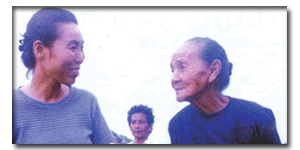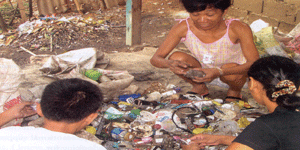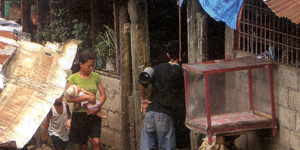The 'Dove' Of San Lazaro
This Columban lay missionary from Korea gives of herself to those on the fringes in Manila.
 When Columban priests in Manila talk about Columban lay missionary Columba Chang, they’ll sometimes refer to her as ‘Saint Columba’, a bit of a tongue-in-cheek reference to the sixth century Irish saint who shares her baptismal name. Very few of them know that she’s actually named after Kim Hyo-im (Columba), one of the canonized Korean martyrs. (See ‘box’). Mostly, however, it’s a token of the genuine respect and admiration for the 49-year-old from Seoul, South Korea, and the exemplary life they have seen her live the past 16 years.
When Columban priests in Manila talk about Columban lay missionary Columba Chang, they’ll sometimes refer to her as ‘Saint Columba’, a bit of a tongue-in-cheek reference to the sixth century Irish saint who shares her baptismal name. Very few of them know that she’s actually named after Kim Hyo-im (Columba), one of the canonized Korean martyrs. (See ‘box’). Mostly, however, it’s a token of the genuine respect and admiration for the 49-year-old from Seoul, South Korea, and the exemplary life they have seen her live the past 16 years.
Columba was an accountant for a bank when she decided to become a lay missionary. At age 33, her parents joked that her motivation was to get away from getting married, but her real inspiration was a tremendous pull to help others. She had worked on weekends with Columban priests in her family’s parish in South Korea and answered the call when they suggested she would make a fine lay missionary.
‘My parents trusted the Columbans because we knew them in Korea,’ she said.
After taking language classes in Tagalog, Columba decided she wanted to work among the poorest of Manila’s poor: the squatters who live on and around the huge garbage dump in Quezon City, which includes some of Metro Manila’s sprawling, poverty-filled suburbs.

The infamous dump is called Payatas – known as ‘Smokey Mountain’. It is at this site of abject poverty where families gather up garbage and pick through the filth with their bare hands, picking out scraps of metal and plastic they can sell to recyclers to earn a few pesos.
Columba took me on a tour last June of the cobbled-together homes and marketplace near the dump site. The small shops, selling packaged foods and meats such as raw pork and sardines, emit a foul odor that mixes with the occasional whiff of feces and rotting garbage. I saw children playing with pebbles and cheap cardboard rather than toys. Families were busy sifting through and sorting trash, looking for anything they could take to the recycler.
In this dire setting, Columba said she immediately felt at home. She spent four years in a Payatas house, now since destroyed, doing various ministries with other religious groups in the area, including conducting home visits of children with mental deficiencies and other birth defects as part of a special education program for children operated by the Vincentian Missionaries.
Because of the environment children born in the grip of ‘Smokey Mountain’ have a high rate of birth defects, such as cerebral palsy, epilepsy, developmental delays, severe cleft palates and encephalitis (swelling of the brain). No studies have confirmed this, Columba says, but the high levels of iron and toxins and toxic fumes most certainly contribute to these defects.

Tuberculosis is rampant here, with about 80 percent of residents suffering from the potentially deadly lung disease. Columba herself contracted TB during her first year there, but it did anything but discourage her.
‘When I got TB, I was happy in that I felt solidarity with the people’, she explained.
Columba said she also grew in her knowledge and understanding of God. As a Catholic in South Korea, she learned to view God as imposing and dominant, a type of male-centric worldview that’s common in Korean culture, she said. Through her work as a lay missionary, she began to see a God who came to Earth in the form of Jesus Christ – ‘vulnerable, helpless, generous and friendly’, in her words. ‘He is there in the midst of the suffering of the people’.
Columba told me she now feels free to be herself, an expression of her personal growth she didn’t experience until she became a lay missionary, which she says has been her true calling from God.
HIV-AIDS Counseling
(Names here have been changed)
After life at Payatas and a year’s sabbatical in England and Wales in 2002-03, Columba returned to Manila, this time to work with Caritas Manila, an arm of the Archdiocese, where she is the HIV-AIDS Progam Coordinator. She counsels persons with HIV-AIDS patients in San Lazaro Hospital and their families. She also brings her ministry to HIV-AIDS patients held in 13 city jails in Metro Manila.
She said she knew little about HIV-AIDS at first, but began to hear stories from Sisters about the stigma that many in Asian cultures face when they contract the disease, which is usually sexually transmitted. Many are prejudged, Columba said, as sex addicts or sex workers, and there are misconceptions about how the disease is contracted.
Officially, the Philippines’ government reports just 2,800 cases of HIV-AIDS in the nation, which, Columba says, is commonly understood to be grossly understated. But as a result of this report, she said, the Catholic Church has put few resources into helping HIV-AIDS sufferers, saying the low numbers of patients means resources can be better directed elsewhere. Columba said she trained herself to learn about HIV-AIDS by gathering information through government agencies.
Columba counsels young men like Clark and Renan, two young men I met who had arrived at the hospital in June for treatment. Both men found out they had the treatable but incurable disease after taking blood tests so they could apply to work overseas. Columba provides them and others with a helpful ear, listening to their stories and worries and providing them with the spiritual and emotional support they are looking for.
‘Patients ask questions like “Where is God? Why me?” I just try to help’, Columba says.
Clark and Renan looked healthy and were scheduled to be released from the hospital to resume their lives and were able to get jobs overseas. Others at the hospital were in more despairing straits.
Gina, with a copy of The Purpose Driven Life at her side, was at the hospital the day I visited, suffering with red rashes caused by the anti-retroviral (ARV) drugs used to treat her.
Armando, a young man from Mindanao, was gaunt and bed-ridden, with a nurse washing his now rail-thin legs dotted with sores. He had denied he was sick for a long time, Columba said, agreeing to a hospital visit only after he had contracted pneumonia. Sadly he has died since.
A New Mission
Columba has applied to become the first Columban lay missionary in Myanmar (Burma), where Columban priests and Sisters were a significant missionary presence in the pre-Second Vatican Council days. Columbans are working to re-establish their presence in this Southeast Asia nation.
Columba said she will soon learn if she is accepted and wants to live in Myanmar because she is ‘looking for more of a challenging place’ and because she wants to teach what she has learned about her Catholic faith and about AIDS, which is a growing problem in Myanmar.
There is no question, Columba said, that she is called to be a lay missionary.
‘This is the way I’d like to live for the rest of my life, to serve the poor’.
Robert Fraass has been the editor of Columban Mission since 2001. He visited Columban missionaries in the Philippines in June 2007. You may email Columba at eunyeal@yahoo.com
ST COLUMBA
‘Columba’ is the Latin for ‘dove’ and is part of the name of a number of Irish saints, the most notable being St Columba or Colm Cille (‘The dove of the chapel’) and St Columban(us), the patron of Columban missionaries. Both of these monks were Irish and contemporaries. Columba’s dates are 521 – 597 while those of Columban are c540 – 615.
The subject of the article, Chang Eun-Yeal, whose Christian name is added, according to the custom of Korean Catholics, is named after Kim Hyo-im (Columba) who with her sister Agnes, was martyred in 1839. The Korean Columba, a woman, was named after the Irish saint, a man.
In his homily in Seoul on 6 May 1984 at the canonization of 103 Korean Martyrs, including Columba and Agnes, Pope John Paul II said, ‘Yearning for an ever greater share in the Christian faith, your ancestors sent one of their own in 1784 to Peking (Beijing), where he was baptized. From this good seed was born the first Christian community in Korea, a community unique in the history of the Church by reason of the fact that it was founded entirely by lay people. This fledgling Church, so young and yet so strong in faith, withstood wave after wave of fierce persecution. Thus, in less than a century, it could already boast of some ten thousand martyrs. The years 1791, 1801, 1827, 1839, 1846 and 1866 are forever signed with the holy blood of your Martyrs and engraved in your hearts’.
The 103 official saints are a ‘sample’ of those of all backgrounds and ages who died in the various persecutions. 20 September is their feast day.
RELATED WEBSITES
You can find Columban Mission at www.columban.org the website of the Columbans in the USA, by clicking on ‘Columban Mission magazine’ on the left.
Caritas Manila is at www.caritasmanila.org.ph
You can find some videos of Vincentian projects in Payatas atwww.famvin.org/wiki/Vincentians_and_YouTube . Scroll down to ‘Vincentians – Philippines’.
There is a restricted online photo gallery by Bobby Wong who works with the Vincentians in Payatas at www.pbase.com/bobbyw/payatas_dump . Bobby has another gallery atwww.pbase.com/bobbyw/mycharities .
www.cmphilippines.org.ph is the website of the Philippine Provinces of the Vincentians, whose official name is ‘Congregation of the Mission’.
